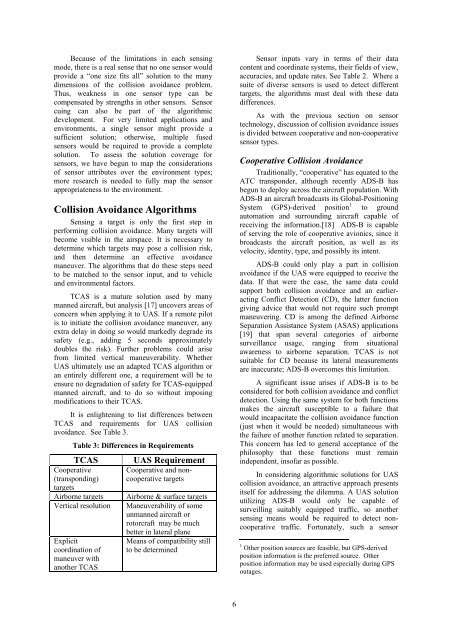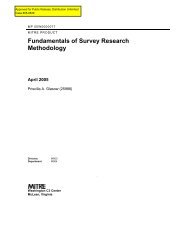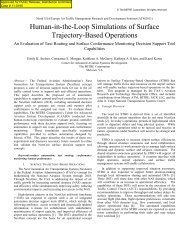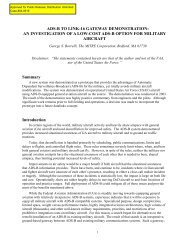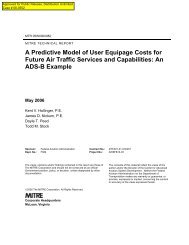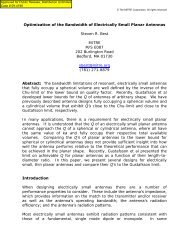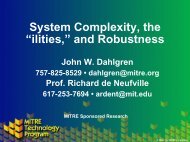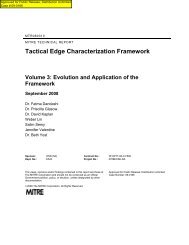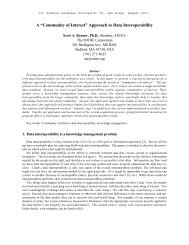Unmanned Aircraft Collision Avoidance: Technology ... - Mitre
Unmanned Aircraft Collision Avoidance: Technology ... - Mitre
Unmanned Aircraft Collision Avoidance: Technology ... - Mitre
You also want an ePaper? Increase the reach of your titles
YUMPU automatically turns print PDFs into web optimized ePapers that Google loves.
Because of the limitations in each sensing<br />
mode, there is a real sense that no one sensor would<br />
provide a “one size fits all” solution to the many<br />
dimensions of the collision avoidance problem.<br />
Thus, weakness in one sensor type can be<br />
compensated by strengths in other sensors. Sensor<br />
cuing can also be part of the algorithmic<br />
development. For very limited applications and<br />
environments, a single sensor might provide a<br />
sufficient solution; otherwise, multiple fused<br />
sensors would be required to provide a complete<br />
solution. To assess the solution coverage for<br />
sensors, we have begun to map the considerations<br />
of sensor attributes over the environment types;<br />
more research is needed to fully map the sensor<br />
appropriateness to the environment.<br />
<strong>Collision</strong> <strong>Avoidance</strong> Algorithms<br />
Sensing a target is only the first step in<br />
performing collision avoidance. Many targets will<br />
become visible in the airspace. It is necessary to<br />
determine which targets may pose a collision risk,<br />
and then determine an effective avoidance<br />
maneuver. The algorithms that do these steps need<br />
to be matched to the sensor input, and to vehicle<br />
and environmental factors.<br />
TCAS is a mature solution used by many<br />
manned aircraft, but analysis [17] uncovers areas of<br />
concern when applying it to UAS. If a remote pilot<br />
is to initiate the collision avoidance maneuver, any<br />
extra delay in doing so would markedly degrade its<br />
safety (e.g., adding 5 seconds approximately<br />
doubles the risk). Further problems could arise<br />
from limited vertical maneuverability. Whether<br />
UAS ultimately use an adapted TCAS algorithm or<br />
an entirely different one, a requirement will be to<br />
ensure no degradation of safety for TCAS-equipped<br />
manned aircraft, and to do so without imposing<br />
modifications to their TCAS.<br />
It is enlightening to list differences between<br />
TCAS and requirements for UAS collision<br />
avoidance. See Table 3.<br />
Table 3: Differences in Requirements<br />
TCAS UAS Requirement<br />
Cooperative<br />
(transponding)<br />
targets<br />
Cooperative and noncooperative<br />
targets<br />
Airborne targets Airborne & surface targets<br />
Vertical resolution Maneuverability of some<br />
unmanned aircraft or<br />
rotorcraft may be much<br />
Explicit<br />
coordination of<br />
maneuver with<br />
another TCAS<br />
better in lateral plane<br />
Means of compatibility still<br />
to be determined<br />
6<br />
Sensor inputs vary in terms of their data<br />
content and coordinate systems, their fields of view,<br />
accuracies, and update rates. See Table 2. Where a<br />
suite of diverse sensors is used to detect different<br />
targets, the algorithms must deal with these data<br />
differences.<br />
As with the previous section on sensor<br />
technology, discussion of collision avoidance issues<br />
is divided between cooperative and non-cooperative<br />
sensor types.<br />
Cooperative <strong>Collision</strong> <strong>Avoidance</strong><br />
Traditionally, “cooperative” has equated to the<br />
ATC transponder, although recently ADS-B has<br />
begun to deploy across the aircraft population. With<br />
ADS-B an aircraft broadcasts its Global-Positioning<br />
System (GPS)-derived position 1 to ground<br />
automation and surrounding aircraft capable of<br />
receiving the information.[18] ADS-B is capable<br />
of serving the role of cooperative avionics, since it<br />
broadcasts the aircraft position, as well as its<br />
velocity, identity, type, and possibly its intent.<br />
ADS-B could only play a part in collision<br />
avoidance if the UAS were equipped to receive the<br />
data. If that were the case, the same data could<br />
support both collision avoidance and an earlieracting<br />
Conflict Detection (CD), the latter function<br />
giving advice that would not require such prompt<br />
maneuvering. CD is among the defined Airborne<br />
Separation Assistance System (ASAS) applications<br />
[19] that span several categories of airborne<br />
surveillance usage, ranging from situational<br />
awareness to airborne separation. TCAS is not<br />
suitable for CD because its lateral measurements<br />
are inaccurate; ADS-B overcomes this limitation.<br />
A significant issue arises if ADS-B is to be<br />
considered for both collision avoidance and conflict<br />
detection. Using the same system for both functions<br />
makes the aircraft susceptible to a failure that<br />
would incapacitate the collision avoidance function<br />
(just when it would be needed) simultaneous with<br />
the failure of another function related to separation.<br />
This concern has led to general acceptance of the<br />
philosophy that these functions must remain<br />
independent, insofar as possible.<br />
In considering algorithmic solutions for UAS<br />
collision avoidance, an attractive approach presents<br />
itself for addressing the dilemma. A UAS solution<br />
utilizing ADS-B would only be capable of<br />
surveilling suitably equipped traffic, so another<br />
sensing means would be required to detect noncooperative<br />
traffic. Fortunately, such a sensor<br />
1 Other position sources are feasible, but GPS-derived<br />
position information is the preferred source. Other<br />
position information may be used especially during GPS<br />
outages.


